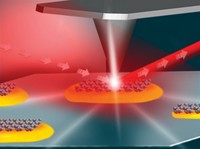Advertisement
Grab your lab coat. Let's get started
Welcome!
Welcome!
Create an account below to get 6 C&EN articles per month, receive newsletters and more - all free.
It seems this is your first time logging in online. Please enter the following information to continue.
As an ACS member you automatically get access to this site. All we need is few more details to create your reading experience.
Not you? Sign in with a different account.
Not you? Sign in with a different account.
ERROR 1
ERROR 1
ERROR 2
ERROR 2
ERROR 2
ERROR 2
ERROR 2
Password and Confirm password must match.
If you have an ACS member number, please enter it here so we can link this account to your membership. (optional)
ERROR 2
ACS values your privacy. By submitting your information, you are gaining access to C&EN and subscribing to our weekly newsletter. We use the information you provide to make your reading experience better, and we will never sell your data to third party members.
Analytical Chemistry
Single-Molecule Reaction Cycle
Method selectively interconverts CN surface species
by Mitch Jacoby
July 2, 2007
| A version of this story appeared in
Volume 85, Issue 27

IN A DISPLAY of uncommonly fine dexterity, researchers have demonstrated a method for selectively breaking and reforming an N-H bond in a single molecule without perturbing adjacent C-H bonds (Science 2007, 316, 1883). The investigation provides a model system for future studies of surface reaction mechanisms and may lead to new routes for preparing nanostructures for use in molecular electronics.
In recent years, researchers in a number of laboratories have shown that individual molecules can be stimulated with the tip of a scanning tunneling microscope (STM) and thereby driven to undergo a variety of chemical reactions at will. But in general, those reactions tend to be irreversible and, in some cases, nonselective.
For example, scientists have used STM tips to remove ligands from surface species or to eject (desorb) molecules from a solid surface by breaking the molecule-surface bond, both of which are typically one-way processes. In other cases, researchers have used the instrument tips to dissociate molecules, thereby generating a variety of molecular fragments.
In the present study, which brought together scientists from Japan and the U.S., the research team coupled the STM's single-molecule capabilities with the catalytic properties of the solid surface on which the molecules were adsorbed to selectively cycle between reactant and product.
Specifically, the group hydrogenated methylisocyanide (C≡N-CH3) to methylaminocarbyne (C=NH-CH3) while monitoring the reaction of individual molecules using STM. Then, they reformed the starting material by using the STM tip to break the N-H bond in methylaminocarbyne molecules adsorbed on a frigid platinum crystal. The hydrogenation step is mediated by the Pt(111) surface, which dissociates hydrogen and catalyzes the reaction between methylisocyanide and atomic hydrogen.
The team, which includes surface chemists Satoshi Katano, Yousoo Kim, Masafumi Hori, and Maki Kawai from Japanese research institute RIKEN, as well as University of Illinois, Chicago, chemistry professor Michael Trenary, suggests that further investigation of the CN-metal linkage may lead to alternatives to the thiol-metal linkage widely employed now in molecular electronics studies.
"One of the biggest challenges in STM work is identifying the species observed in the images," Trenary notes. That task was made possible, in part, due to earlier work in which Trenary's group used a surface-sensitive infrared spectroscopy method to probe the hydrogenation reaction in monolayers of methylisocyanide. Data interpretation was also aided by the use of inelastic electron tunneling spectroscopy, a technique that measures vibrational spectra for individual adsorbed molecules.
University of Washington, Seattle, chemistry professor Charles T. Campbell comments that the "compelling evidence" presented in the study was gathered through the group's mastery of several state-of-the-art techniques, including low-temperature microscopy, single-molecule vibrational spectroscopy, STM-tip-induced chemistry, and surface IR spectroscopy. "The study shows us what elegant control humankind is now capable of exerting over catalytically active metal surfaces," he says.




Join the conversation
Contact the reporter
Submit a Letter to the Editor for publication
Engage with us on Twitter